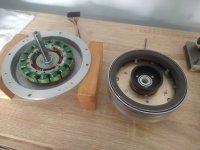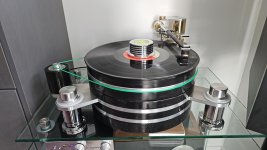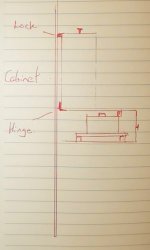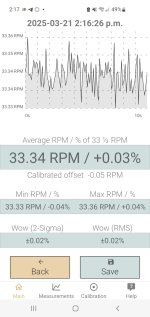I will ask a friend machinist to make a groove in the AL part of platter (as in pic above).Round belts tend to process up and down the platter/subplatter unless there is a tight groove to hold it in place.
Thanks SP,
That was one of my mistakes, and it is going to be addressed shortly. Housing will be of sintered bronze and the spindle will have an SS sleeve.
I wouldn't use SS my DIY bearing in an SP10mk2 used 12mm BS1407 Silver Steel shaft with a 5mm SI3N4 ball running in Vesconit Hilube bushes and thrust pad. Speed stability is better than a stock SP10mk2. The latest iteration uses a solid carbide spindle but this was very expensive to have ground.
SS is gummy and depending on the grade impossible to harden. The BS1407 running in the Vesconite bushes are also much quieter than bronze and require no oil bath.

The key requirement of a TT bearing that's unique is that of very low mechanical noise at low speed. I think this usually forces use of a heavy oil and precision bushing approach plus ball-bearing on thrust-plate.
I am surprized by any attempt to use Al as a bearing metal, its surface oxidation makes this unworkable as the surface Al2O3 quickly becomes a grinding paste as even a brief experiment would demonstrate. Typically Al on Al will quickly spall and roughen and then seize up as the oxide takes up more volume than the metal. However anodized aluminium can work as a bearing surface against say teflon or in an air-bearing, where there is no oil or grease and contact pressure is low.
I am surprized by any attempt to use Al as a bearing metal, its surface oxidation makes this unworkable as the surface Al2O3 quickly becomes a grinding paste as even a brief experiment would demonstrate. Typically Al on Al will quickly spall and roughen and then seize up as the oxide takes up more volume than the metal. However anodized aluminium can work as a bearing surface against say teflon or in an air-bearing, where there is no oil or grease and contact pressure is low.
THANK YOU ALL for valuable opinion and suggestions. It is fixed now by:
1. Changing shaft and housing
- Shaft is made of polished stainless steel
- Housing is made of sintered (oiled) bronze
- Diameter is reduced to 10mm
2. Pulley is redone with very tight clearance
Wow is reduced to 0.1% (or less).
Also, a round belt stays in place without a grove. Two wooden plates above and below AL one, where belt sits, are very slightly wider than the AL one so there is no chance of slippage.
Attached is a picture of entire turntable, including Schroeder tone arm clone, me, happy 🙂
1. Changing shaft and housing
- Shaft is made of polished stainless steel
- Housing is made of sintered (oiled) bronze
- Diameter is reduced to 10mm
2. Pulley is redone with very tight clearance
Wow is reduced to 0.1% (or less).
Also, a round belt stays in place without a grove. Two wooden plates above and below AL one, where belt sits, are very slightly wider than the AL one so there is no chance of slippage.
Attached is a picture of entire turntable, including Schroeder tone arm clone, me, happy 🙂
Attachments
DARN good question B) I wanted to make a dust cover as well, but wife asked "WHY? It looks nice as is" (which fulfill a WAC). I'll dust clean it (very often, indeed) with soft cloth.
I'd guess by looking at that nice piece of work that you're also using a cart worth keeping useful as long as possible. I suggest you can take an old LP you intend never to use, take the label off one side or put a photo or something over it so you can always tell top from bottom and leave it on the platter as dust cover when not in use. At least you keep dust from building up on the platter and then getting on the record being played.
Cleaning often is the main enemy of the cart.DARN good question B) I wanted to make a dust cover as well, but wife asked "WHY? It looks nice as is" (which fulfill a WAC). I'll dust clean it (very often, indeed) with soft cloth.
There are minimal dust protection shaped like a record and have also a protection to the TA and cart.
Rgds
Adelmo
In my experience a playing disc generates enough static electricity to pull significant dust toward it - with a dust cover this means the supply of dust is limited to that in the volume of the dust cover, reducing the amount of dust reaching the playing surface. Short of having a cleanroom or controlled humidity, a dust cover is powerful tool to reduce dust accumulation - anti-static formulations are also desirable to reduce the effect.
Having a dust cover also allows you to leave a disc on the platter when not in use without dust settling by gravity, keeps insects off, sneezes, you name it!
Having a dust cover also allows you to leave a disc on the platter when not in use without dust settling by gravity, keeps insects off, sneezes, you name it!
I have wondered what results a heavy large platter would give. 0.1 % is not bad , there is a phone app that tests this and speed .
Mine did well
Which app is that, please?
Dust is everywhere and vinyl attracts it. No question. Its not really avoidable, but keeping the room well cleaned, and using good dust cleaners help. A wet vac record cleaner is not a bad thing to have if you're a serious vinyl user.In my experience a playing disc generates enough static electricity to pull significant dust toward it - with a dust cover this means the supply of dust is limited to that in the volume of the dust cover, reducing the amount of dust reaching the playing surface. Short of having a cleanroom or controlled humidity, a dust cover is powerful tool to reduce dust accumulation - anti-static formulations are also desirable to reduce the effect.
Having a dust cover also allows you to leave a disc on the platter when not in use without dust settling by gravity, keeps insects off, sneezes, you name it!
The downside of leaving the typical dust cover on while the record is playing is that it acts like a sail for mechanical capture of acoustic energy, the sound that comes from the speakers.
At low SPL, it's not a problem but turn the volume up, and the acoustic feedback level also goes up. Virtually guaranteed. A floating suspension in a massive base on a really secure stable stand will be okay, but typical TT setups benefit audibly at louder levels when the dust cover is removed altogether.
A subsonic filter can help a bit but it's only a bandaid, it doesn't eliminate the intrusive vibration. Placing the TT well or even in another room, is usually more effective but not always practical. Removing the cover during play is simpler.
Last edited:
It is called 'RPM Speed and Wow", free app available in "Play Store" for Android. Most likely for iWhatever as well.Which app is that, please?
Hmm, scope for innovation for a dust-cover design that is resistant to feedback - separately mounted from the TT itself perhaps?but typical TT setups benefit audibly at louder levels when the dust cover is removed altogether.
I did consider making a minimalist steel frame or aluminum with soft rubber feet in the shape & size of a typical dust cover covered in a gauzy fine see-through fabric (like stockings?) that would keep most dust out. If using metal tubes, they could be filled with expanding foam for damping. You'd need some heavy duty springs in the hinges if you wanted the cover to stay open... or some other way to hold it open.Hmm, scope for innovation for a dust-cover design that is resistant to feedback - separately mounted from the TT itself perhaps?
But I never got around to it & eventually stopped playing LPs altogether.
(Too many limitations and fuss with vinyl & most CD (or better) digital media is clearly superior in my perception.)
I had this issue with the Schiit Sol TT when I first got it. As it turns out, the belt wandering was caused by twists in the belt that were formed by storing it folded in the bag. After a period of use the belt lost its twist and rode the platter rim properly without wandering. For this reason, I think it's a good idea to store any spare belts unfolded so they're ready to use when needed.Round belts tend to process up and down the platter/subplatter unless there is a tight groove to hold it in place.
On the subject of belts, I agree with the suggestion to use thread instead of rubber. I tried this with the Sol amd found the music had more 'drive' , but it also transmitted motor vibration to the platter causing audible hum. The Sol is a very lightweight table (both platter and motor unit) so the noise transmission is understandable, but it shouldn't be a problem with a deck of sufficiently high mass.
- Home
- Source & Line
- Analogue Source
- Huge wow on diy turntable



